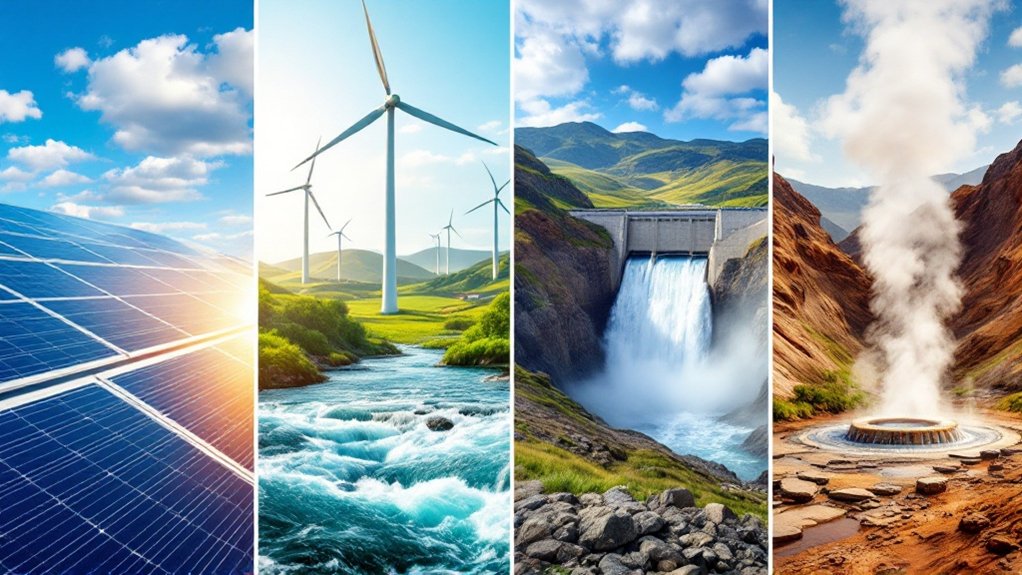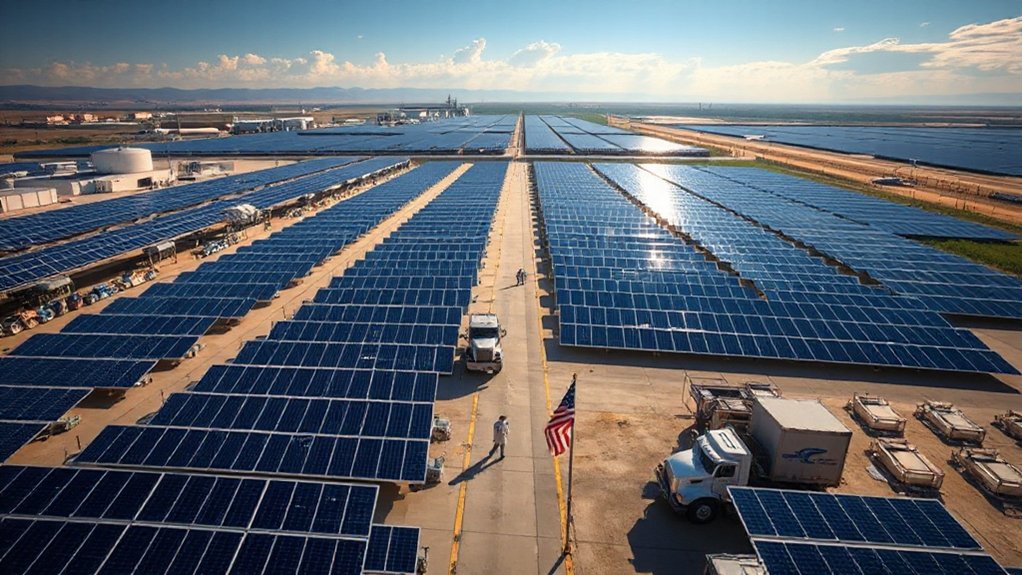Renewable resources come in several flavors, each with unique advantages. Solar energy leads the pack as nature's most abundant power source, while wind farms generate a whopping 29.4% of the UK's electricity. Hydroelectric dams contribute 16% globally, providing steady power when the sun doesn't shine. Geothermal taps Earth's core heat, and biomass energy makes up 10% of global energy. These sustainable options paint an intriguing picture of our energy future.

The future of energy isn't buried deep underground – it's all around us. Solar energy, nature's most abundant power source, has become increasingly accessible as photovoltaic cell prices have plummeted 89% since 2010. It's literally everywhere, though it does play hide-and-seek with clouds and takes nightly breaks. Sustainable alternatives to fossil fuels provide a cleaner path forward for our energy needs. These energy sources help reduce greenhouse gas emissions that harm our climate.
Nature's power plant is all around us, with solar leading the charge as prices drop and accessibility soars.
But when the sun's not showing off, wind power steps up to the plate. Just ask the UK, where spinning turbines provide a whopping 29.4% of their electricity. Wind farms, both onshore and offshore, have seen explosive growth – we're talking a 53% increase globally in just five years. Modern wind turbine technology has revolutionized renewable energy generation worldwide.
Water's been in the renewable energy game longer than anyone else. Hydropower is the old reliable of clean energy, contributing 16% of global electricity production. Those massive dams aren't just for show – they're working round the clock, providing steady power when solar and wind decide to take a breather.
Meanwhile, deep beneath our feet, geothermal energy taps into Earth's natural heating system. It's like having a power plant in Earth's basement, churning out a constant 14.9 GW globally. The catch? You need to be in the right neighborhood, geologically speaking.
Biomass energy proves that one person's trash can be another's treasure. From wood to crop waste, it's serving up 10% of global primary energy. It's carbon neutral too – as long as we're replanting what we burn.
The oceans aren't sitting this one out either. Tidal energy harnesses the moon's gravitational pull with clockwork precision, while wave energy is making splashes with its massive potential – we're talking 29,500 TWh per year.
Sure, wave technology is still getting its sea legs, and those marine environments can be brutal on equipment. But that's the thing about renewable resources – they're not just clean alternatives, they're the ultimate long-term investment. After all, the sun isn't sending us a bill anytime soon, and the wind hasn't figured out how to charge by the breeze.
Frequently Asked Questions
How Long Does It Take for Renewable Resources to Replenish Themselves?
Renewable resources replenish at wildly different rates.
Solar energy hits Earth in just 8 minutes, while wind patterns shift hourly.
Water takes 9 days to complete its atmospheric cycle.
Biomass varies dramatically – algae doubles daily, but trees need 3-10 years to mature.
Pretty impressive stuff, actually. Nature keeps the supply flowing, unlike those pesky fossil fuels that take millions of years.
What Percentage of Global Energy Currently Comes From Renewable Sources?
According to recent data, renewables make up roughly 13% of total global energy consumption – not exactly earth-shattering numbers.
The electricity sector shows more promise, with renewables generating about 30% of global electricity in 2023.
Modern bioenergy chips in at 6.5%, while total renewable energy supply hit 5.7% of the global mix.
Progress? Sure. Revolutionary? Not quite yet.
Which Renewable Resource Is Most Cost-Effective for Home Installation?
Solar energy takes the crown for home installations – no contest. The numbers don't lie: hefty upfront costs of $15,000-$25,000, but massive electricity bill reductions of up to 80%.
Payback periods range from just 3.7 years to 19.1 years, depending on location. While other renewables like wind and geothermal have their merits, solar's proven track record and decreasing costs make it the clear financial winner for residential use.
Can Renewable Resources Completely Replace Fossil Fuels in Transportation?
Renewable resources could theoretically replace fossil fuels in transportation – but we're not there yet.
Electric vehicles and biofuels are making headway, potentially replacing over 50% of oil use by 2040.
The real challenges? Massive infrastructure needs, high costs, and technological limits.
Aviation and shipping remain particularly tough nuts to crack.
Green hydrogen and synthetic fuels show promise, but full change requires serious technological breakthroughs and policy support.
How Do Weather Conditions Affect the Efficiency of Renewable Energy Systems?
Weather can wreak havoc on renewable energy systems.
Solar panels lose efficiency in high temperatures and cloudy conditions – not ideal. Wind turbines shut down during extreme winds and ice up in winter. Droughts hit hydropower hard, while floods can damage infrastructure.
Even humidity takes a toll, reducing solar output by up to 20%. Mother Nature keeps renewables on their toes – constantly reminding us who's boss.









